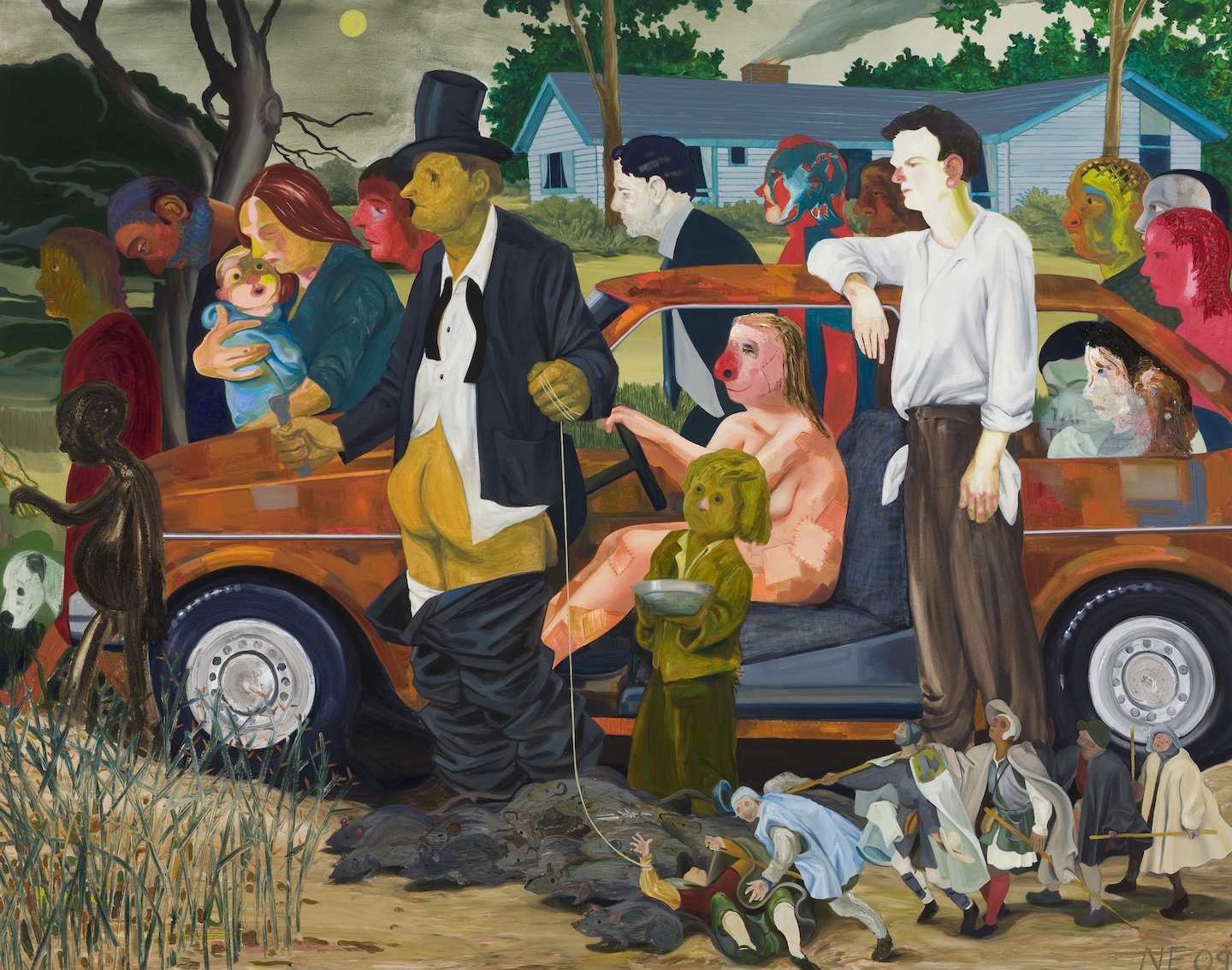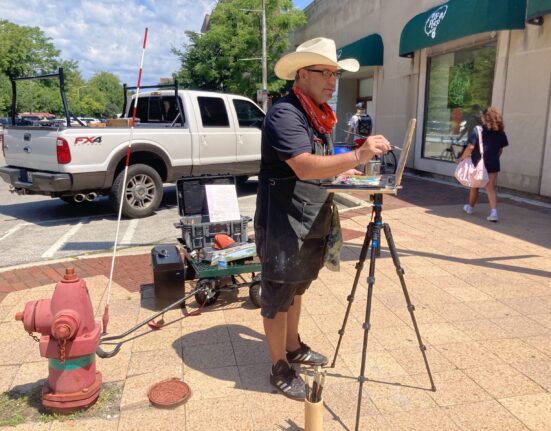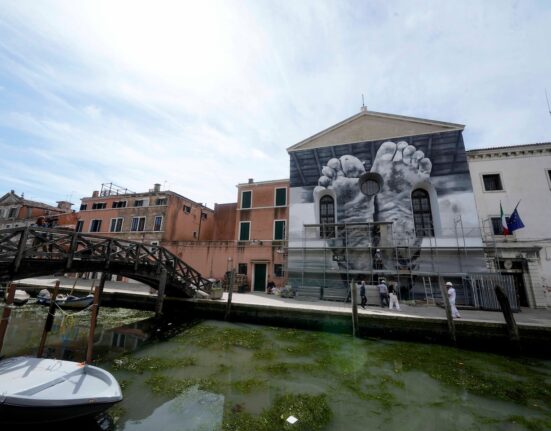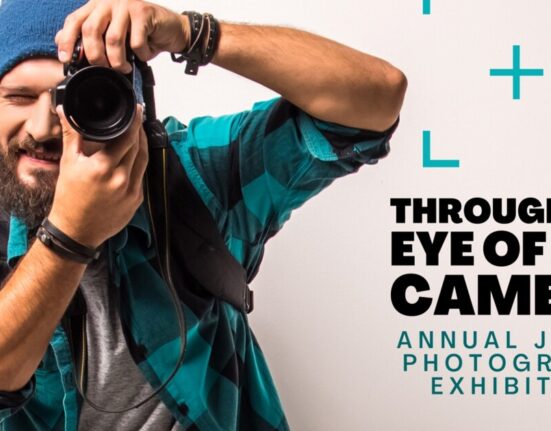Her prime method is dark humor. But there’s plenty of room, too, for righteous anger, tenderness and love.
Eisenman, 59, is our most inventive and irreverent — and often times our most startlingly intimate — contemporary painter. Her style is really several styles, across several media — not just painting but also printmaking, collage and sculpture.
Her best-known works combine strains of socialist realism (both parodic and sincere) with cartoons, caricatures and flattened stylizations derived from modernist abstraction. She paints elaborate political allegories, intimate depictions of loneliness and screen dependency, and beautiful, at times breathtakingly ambitious pictures of parties, protests and gatherings in beer gardens.
At first, as you watch Eisenman switch between modes, something about the performance can feel hammy, like a costumed reenactment of a 19th-century séance. But the drama deepens, the hammy-ness mysteriously dissolves, and you can’t look away.
Eisenman likes to work on a large scale and to pack her pictures with detail. A connoisseur of textures and colored patterns, she is alive to all the different varieties of work that paint can do in any given composition. She uses the paint’s facture not only to seduce but also, on occasion, to repel, converting the promise of sensuousness into ashes in the mouth.
Heads are important to her. One gallery at the MCA is filled with them, executed in every conceivable style and medium. Important, too, are toes and hands, often bulbously enlarged, cartoonlike, peculiarly foreshortened and made to do all kinds of psychic work.
You can feel the influence of scores of artists behind what she does. The ones that came most often to my mind in Chicago were Max Beckmann (his taste for crowded compositions and allegory), Marsden Hartley (Eisenman’s huge sculptural installation explicitly honors him), Philip Guston and Neo Rauch.
Eisenman, who lives in Brooklyn, was born in France (her father was stationed there as an Army psychiatrist) and is of German-Jewish descent. She emerged in the 1990s, just as the revival in figurative painting was gathering steam. In those years, many artists, turned off by abstraction and conceptualism, felt the only viable way to make figurative art (passé for so long) was in a high ironic mode.
“Bad painting” became the order of the day. Inspired by the naughtiness of late-period Francis Picabia, who painted girlie pinups when others were gnashing their teeth over the problem of how to live and paint authentically, many artists were moved to do precisely what their art teachers were telling them they shouldn’t.
John Currin and Lisa Yuskavage taught themselves to paint sexy nudes in Old Master styles. Glenn Brown painted airbrushed copies of Frank Auerbach’s heavily encrusted oil paintings. Elizabeth Peyton painted delicate fangirl portraits of beautiful pop stars and young actors. Meanwhile, careening between abstraction and figuration, Martin Kippenberger, Kai Althoff and Albert Oehlen trashed the very idea of a consistent personal style, painting whatever and however they wanted.
Eisenman was heir to all this. She embraced the ambient irony and eclecticism, channeling Picabia’s devil-may-care, kaleidoscopic attitude to style (Dada one minute, pseudo-classicism the next). Immersed in her queer and bohemian milieu, she painted and drew parodies of Old Masters, magazine advertisements and Disney cartoons.
Eisenman’s aim, broadly speaking, was subversion. She mastered multi-figured compositions from High Renaissance and Baroque painting, emulating them with a kind of manic, mocking intensity. “Captured Pirates on the Island of Lesbos,” for instance, plays out a castration scene in an ink wash drawing rendered in classical chiaroscuro.
Like Currin and Yuskavage, Eisenman was interested in how the rules and conventions of established historical styles contained their own corruption, their inherent tendencies toward perversion. So she translated their religious, phallocentric subjects into broad lesbian fantasies, often stepping on taboos. One of Eisenman’s Old Masterly compositions combines the innocence of a lemonade stand with the sexual kink known as the “golden shower.” No one wanted to have to think about that — but Eisenman went there, laughing out loud.
Another of her Baroque-style inventions shows a pregnant woman giving birth while suspended from a tree branch with a noose around her neck. In a compressed, vertical composition that reads like a Nativity scene for a church altarpiece, the woman is surrounded by men, one of whom blows a party horn at her, while another stares at the emerging baby through a telescope.
At a certain point in the early 2000s, Eisenman seemed to tire of these postmodern caperings. Without losing any of her dark humor, her anti-establishment politics or her penchant for perversity, she began to deepen the game.
Her work from this period expresses a crisis familiar to most artists: the crisis of audience. As in: “Who am I doing this for?” If the answer (as it had been until then) was “myself and my people” — a small group of intimates who convene life drawing classes and poetry readings at one another’s homes, attend protest rallies and sunbathe on Fire Island in the summer — that no longer felt quite sufficient.
Gradually, after a difficult period when her career seemed becalmed, Eisenman transformed herself from a niche artist talking to her people in a coded language into a deeper kind of creative provocateur — someone prepared to address not just politics but also intimacy, solitude and the problem of communal existence.
In the process, she became a MacArthur fellow, participated in multiple Whitney Biennials and became an officially sanctioned art star, haggled over by savvy collectors, rubber-stamped by museum curators. What made this happen was neither art world machinations nor market manipulation. It was what Eisenman did with paint (and sculpture). It was a step up in ambition, a palpable raising of the stakes.
You feel it in this show — appropriately subtitled “What Happened” — as you move from one gallery to the next. (The exhibition, which has come to Chicago from Munich and London, was organized by Monika Bayer-Wermuth and Mark Godfrey with the assistance of Cameron Foote and, in Chicago, Jadine Collingwood and Jack Schneider.)
I understood “What Happened” (not a stupefied question but a blunt statement) as a reference to everything that has lately gone wrong with the world. But it could also apply to Eisenman’s career: “What happened” is, in essence, that she just got very, very good.
She also became (I think) more melancholy. One gallery here is filled with works addressing politics, mostly in rambunctious allegorical terms. “The Triumph of Poverty,” for instance, is a response to the 2008 financial and political crisis. It draws on a lost painting of a procession of vices by Hans Holbein and includes a quotation from Pieter Bruegel the Elder’s “The Blind Leading the Blind.” The resulting masterpiece is a lot of things, none of them optimistic.
Another gallery has works that reflect, grimly, on our fixation with cellphones, television remotes and screens generally. The compositions make you question who is looking at whom and are fantastically inventive. But their general aura is bewildered and lonely.
Why, I wondered as I lingered in this gallery, are the artists who speak most powerfully to us so rarely happy? The question no doubt requires an elaborate answer, hedged with qualifications. But we could also say it simply:
Art, at its best, starts from a premise of aliveness. Aliveness (in the forms of humor, sensuality, richness of response) is attached at the hip to awareness. Awareness (the human brain and body liberated from sentimentality, propaganda and all other forms of denial) involves registering the full extent of the debacle. But acknowledging the debacle, in turn, plunges us into depression — the very opposite of aliveness.
Something like this dynamic inheres in Eisenman’s work. Her paintings and brilliant sculptural ensembles are totally alive — sometimes almost maniacally so. But they’re also continually collapsing into a stunned stasis. When they emerge again, it’s into states of bafflement as the artist tentatively gropes after community, which she tenderly, gratefully celebrates.
Eisenman’s art, in other words, both registers the debacle and provides her — and the rest of us, her happily proliferating audience — with an expanded repertoire of how to feel alive (none of the options involving our cellphones). She uses art for play and laughter and lamentation and, above all, for cracking open the possibilities — lately so tragically diminished — of who we might be.
Nicole Eisenman: What Happened Through Sept. 22 at the Museum of Contemporary Art Chicago. mcachicago.org







